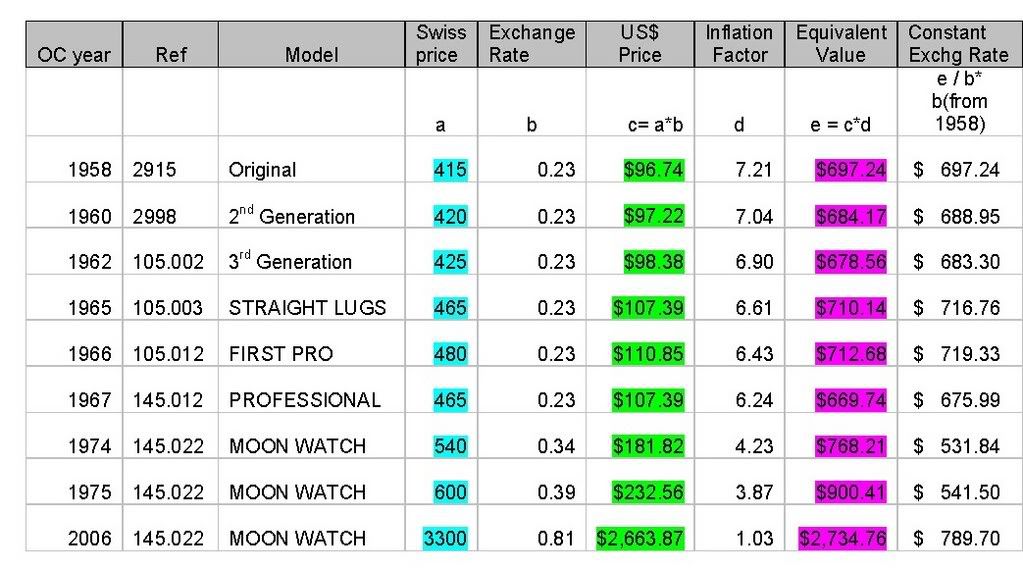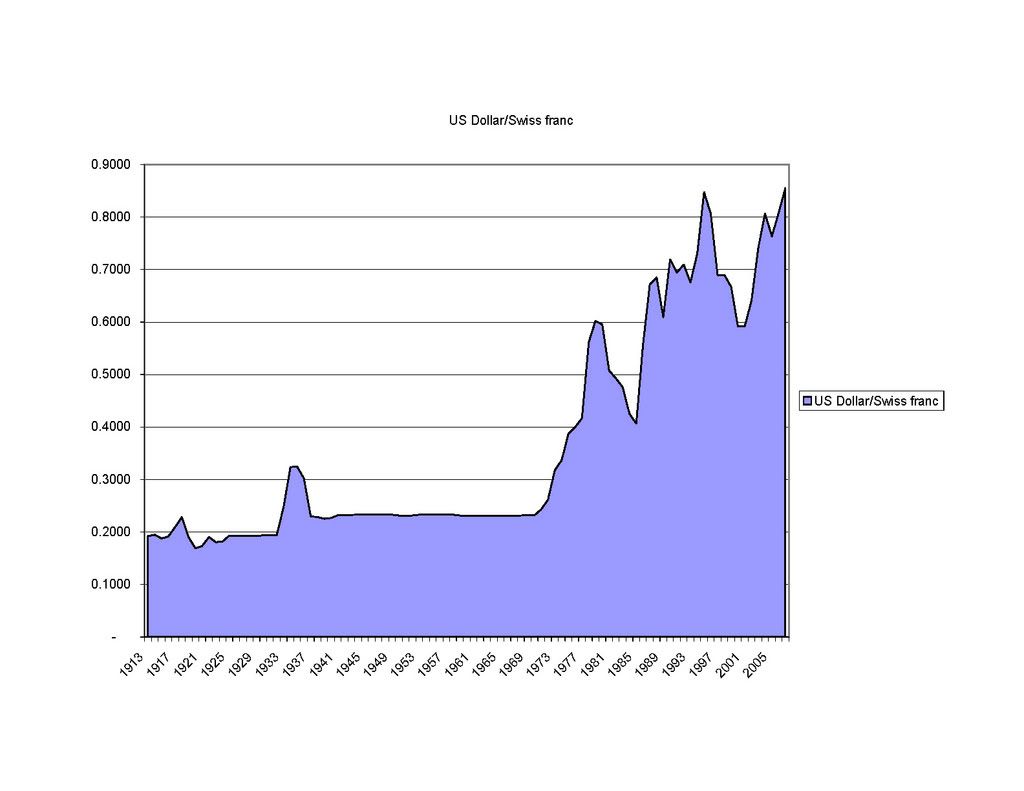Speedy prices . . . posted originally in fall 2007
I think we WIS only believe we understand what has happened to watch prices since the 1960s. One factor I have never heard mentioned has a huge and unrecognized effect.
We know the quartz revolution drove prices down initally, putting hundreds of Swiss firms under. Later, mechanical watches came back as luxury goods, with much higher prices that we see today.
We know inflation drove prices up, especially in the late 1970s and early 1980s.
But what we don't consider is how the exchange rate between the US dollar and the Swiss franc had an effect on prices. I think it had a hand in the so called quartz crisis.
Let's use different models of what is now the Speedy Pro to illustrate my point. Omega's vintage database gives us Swiss retail prices at various points in time. The 145.022 has been redesignated, but basically the same watch is sold today as in the 1970s with minor differences in the bracelet, a Delrin brake and Superluminova, and changes in movement plating. Not much has changed.

Look at how much the Swiss retail prices have increased (see the blue figures)- from 1975 to 2006 -- about 5.5 times. That's the effect of inflation and real price increases on Swiss prices.
Let's change Swiss francs into US dollars using the exchange rates in effect then. This should give us approximately what the US prices were. These are the green figures.
Wow! Since 1975 the prices have gone up over 10 times! US prices have gone up 10 times, but Swiss prices have gone up only 5.5 times. How did that happen? We'll come back to that later.
Let's adjust the old prices upward to an exquivalent amount of today's dollars, using the US CPI. The fuscia or pink figures are what the estimated US dollar prices we calculated using the old exchange rates would be in today's dollars.
It sure looks like Omega has raised prices outrageously -- tripling them over and above inflation -- since 1975. US dollar prices today are even higher than this conversion of Swiss prices shows, if I recall the current price of a Speedy Pro, which is about $3,200, not the $2,700 calculated. (Remember -- this table starts from Swiss retail prices.)
Luxury goods pricing indeed! Except for one thing -- look at the exchange rate. The US changed to allow the US dollar to float on the open market in the early 1970s. This chart shows how much we paid to purchase one Swiss franc.

What cost a US purchaser of Swiss goods about $0.23 from 1937 to 1970 now costs $0.85 -- almost 4 times more. That's a huge amount of the increase in the cost in the Speedy Pro. Not as much as inflation, but still a huge factor that no one ever mentions or seems to consider. I suspect the Swiss couldn't get price increases in the US market and their sales dried up, just as the Japanese were taking market share elsewhere. This had to be a factor in the Swiss watch industry collapse.
Just for fun, let's take the inflation adjusted numbers in the table above and assume that the $0.23 exchange rate that existed for over 30 years was in place for all the watches we have prices on.
The last column is what the historical prices would look like, in today's dollars, assuming a Swiss franc costs $0.23, like it did from about 1937 to about 1970.
After removing the exchange rate from the numbers, a Speedy has usually cost about $700 in today's dollars, except in the mid-1970s when quartz pushed prices down (if you could get the 0.23 exchange rate). The Speedy price today is higher than it has ever been, even after accounting for inflation and exchange rates, by about 25-30%.
Let's consider an example going the other way in time, to check my math. The Speedy has a MSRP of about $3,200 today. In 1967, the same buying power would only require $513 dollars ($3,200/6.24).
The exchange rate right now is about 0.85. The Swiss price should have been about CHF 603 ($513/.85). The price of a Speedy Pro was actually CHF 465, showing about a 30% increase in real prices not explained by inflation or exchange rates.
The strength of the Swiss franc also means Omega will continue to raise prices in the US by a healthy amount, more than inflation.


